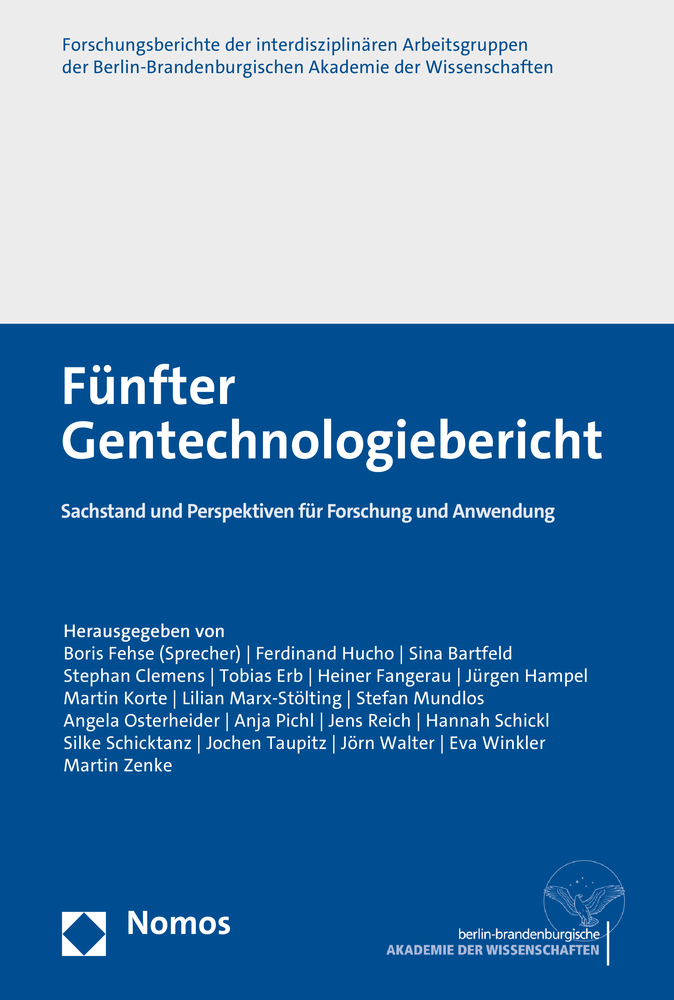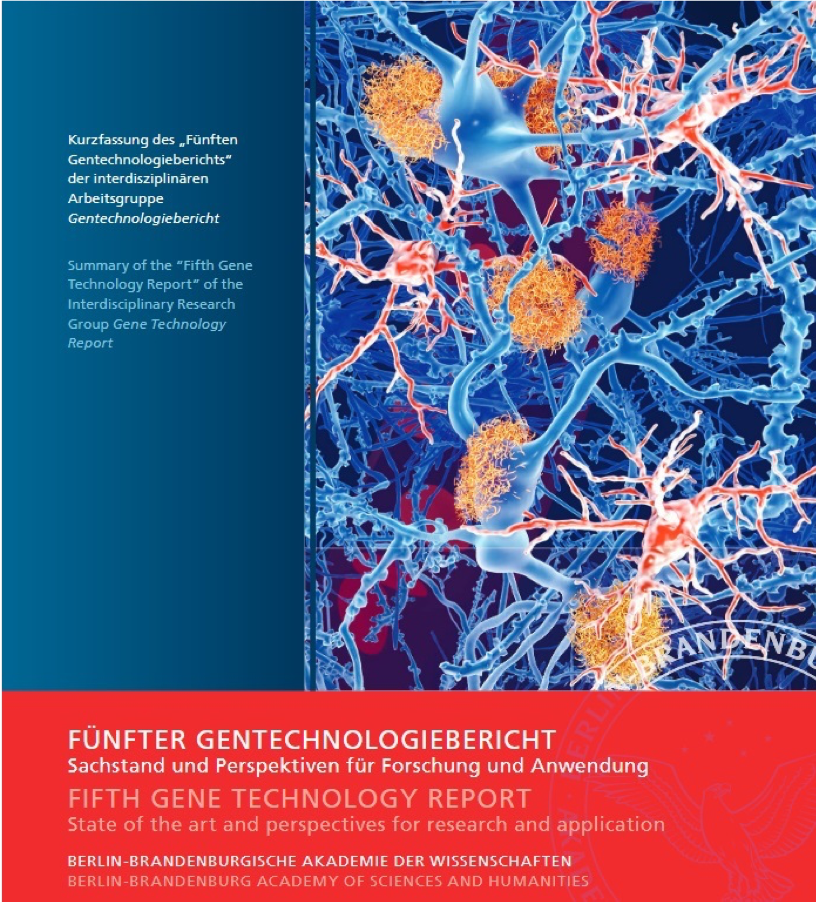Main navigation
5th Gene Technology Report – a critical observation of a cutting-edge technology
For around 20 years, a group of researchers from various disciplines has been monitoring and accompanying the development of genetic technologies. The societal importance of genetic technologies was demonstrated during the coronavirus pandemic, when it was possible to rapidly develop suitable vaccines thanks to genetic engineering methods. As a result, the Fifth Gene Technology Report published in autumn 2021 reads like a validation of many years of work, as well as making it clear that the will to continue the detailed long-term monitoring is very much present.
The report focusses specifically on the following subject areas of gene technology: epigenetics, gene diagnostics, gene therapies, vaccine development, stem cell and organoid research, green genetic engineering, synthetic biology, gene drives, and the cross-sectional methods of genome editing and single-cell analysis. This sounds like a difficult read, but it is not. The authors’ efforts to break down unwieldy and complex issues into something that is easy to understand is a major feature of the report.
‘Observatory’ with advisory function

But this is not all. The 600-page report takes its readership’s time and availability seriously. The first 80 pages of the report contain core statements on the scientific states of affairs, including short and long versions of recommendations for action, the latter presumably aimed specifically at specialist policy-makers.
The interdisciplinary research group Gene Technology Report sees itself at the interface between science, politics, industry and society and wants to enable "more transparency" and "broad public discourse". With the help of indicators - measurable parameters such as the number of publications, funding and relevant events - the Fifth Gene Technology Report, like its predecessors, analyses and highlights the relevance of certain problem areas from scientific, ethical, social and economic perspectives.
Knowing one's limitations
Using genome editing as an example, the authors show that the public can only understand complex biological processes when imagery is used to describe them. However, this is sometimes done at the expense of accuracy: "Both the metaphor of ‘editing’ and the boom in the concept of precision (...) obscure the problem that the global effects of changes to the genome, even when they are very precise, are so far often unpredictable, as there is still very limited knowledge about how genes function and interact with each other and with the environment." (p. 225)
Somatic gene therapy - upswing with a long run-up

It is exciting and instructive to see how Boris Fehse depicts in great detail the path somatic gene therapy took from the laboratory via clinical trials to commercial application. He also provides some great examples. Thanks in part to spectacular therapeutic successes, gene therapy on somatic cells has experienced a sustained upswing in recent years. Further imminent approvals and a high number of clinical trials substantiate this trend.
The author points out that research on immunotherapy was instrumental in the rapid development of highly effective vaccines against SARS-CoV-2 within a year of the first patients falling ill with COVID. The mRNA vaccine platform was initially developed and used for immunotherapy for cancer patients. It is thanks to many years spent optimising the mRNA technology as well as entrepreneurial courage and skills that worldwide vaccination against the pandemic virus has been possible.
This cross-reference to the beginnings of this genetic engineering method shows that it sometimes takes decades of development before a technology can be used safely and effectively in humans, especially when it comes to technology fields with possible clinical application. Looking back to the early days of genetic engineering is particularly important with regard to somatic gene therapy, which for many years was characterized by small advances and major failures, in order to be able to correctly assess clinical successes. Not to mention germline modifications, which are still awaiting broad ethical discussion beyond purely professional circles.
Using CAR T-cell therapy as an example, Fehse shows why this approach works well for certain diseases of the haematopoietic system, and why it does not yet work for (more common) solid tumours. In addition to approaches focussing on the direct destruction of tumours by genetically modified oncolytic viruses, diverse research activities focus on the correction of genes involved in hereditary monogenic diseases. It has been shown that although in vitro and in vivo gene therapy approaches for hereditary monogenic diseases have led to some spectacular clinical successes, serious (sometimes fatal, as in the case of Zolgensma in August 2022) side effects have also been reported in some cases, and require careful risk-benefit assessments.
Basic research - yes, application - no
Despite the enormous clinical potential of somatic gene therapies, they remain complex, help comparatively few people, are very expensive (2.3 million euros for a drug to treat childhood spinal muscular atrophy) and require considerable preclinical and clinical research and work. Fehse bemoans the fact that internationally competitive basic research in Germany is struggling to take the step toward translation. He calls for "new structures and funding instruments" (p. 179).
Imparting knowledge is not enough

In Europe, green genetic engineering has long existed in the shadows. The 2018 decision by the European Court of Justice on genome-edited plants is likely to change little in this regard. This is because the technology continues to struggle with cultural unease associated with industrial agriculture. Contributions to this topic note and eloquently lament this lack of understanding of scientifically unprovable attitudes and mindsets. But it also exposes a widespread blind spot among experts: namely, the naïve conviction that people form their judgments and views on the basis of established facts. Additional knowledge can even exacerbate existing polarization. This has been shown by the debate on vaccination and thus confirmed findings from social psychology.1)
It is worth making the effort to read individual contributions to the Fifth Gene Technology Report. Here we cite just three examples. The short paragraph entitled “Limits of knowledge and communication” (P. 224f) dealing with two cross-sectional technologies, namely, genome editing and single-cell analysis, points out the need to recognise the limits of actions we all take as individuals, discuss and draw conclusions from them, even if they are unpopular. This paragraph is an excellent example of self-reflection and policy advice.
We are learning that science has abandoned the paramount importance of genes in the post-genome era ("The open future of the gene," p. 261f.), and that, with the possibility to edit the epigenome, science has begun to discover a new field of research beyond DNA.
What is decisive is what is done with gene technology
The conclusion of the Fifth Gene Technology Report is tantamount to a rejection of faith in technology: it is not gene technology itself that is foregrounded, "but what is made of it. Gene technology communication that sees itself as science marketing or pure science communication in the sense of conveying factual knowledge alone thus misses the point of society's need for discourse" (p. 520). If the research group continues to take this approach, we can already look forward to the 6th Gene Technology Report.
References:
Boris Fehse (Sprecher), Ferdinand Hucho, Sina Bartfeld, Stephan Clemens, Tobias J. Erb, Heiner Fangerau, Jürgen Hampel, Martin Korte, Lilian Marx-Stölting, Stefan Mundlos, Angela Osterheider, Anja Pichl, Jens Reich, Hannah Schickl, Silke Schicktanz, Jochen Taupitz, Jörn Walter, Eva C. Winkler und Martin Zenke (Eds.): Fifth Gene Technology Report. State of the art and perspectives for research and application, Baden-Baden: Nomos (2021). Available online at: https://www.nomos-elibrary.de/10.5771/9783748927242/fuenfter-gentechnologiebericht
1) Maximilian Probst, Ulrich Schnabel: "Was Experten lernen müssen", Zeit 21st April 2021, p. 31f. and Martin Reich: "Wissenschaft auf den Acker!", BioTechnologie Kursbuch 35, 2022, p. 41-56.
2) Report of the Office of Technology Assessment at the German Bundestag on "Genome Editing am Menschen. Endbericht zum Monitoring". Full text: doi:10.5445/IR/1000141083, published 14th December 2021.